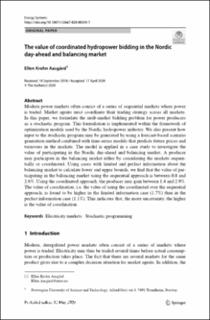| dc.contributor.author | Aasgård, Ellen Krohn | |
| dc.date.accessioned | 2020-08-26T06:20:28Z | |
| dc.date.available | 2020-08-26T06:20:28Z | |
| dc.date.created | 2020-06-05T07:12:48Z | |
| dc.date.issued | 2020 | |
| dc.identifier.citation | Energy Systems. 2020, | en_US |
| dc.identifier.issn | 1868-3967 | |
| dc.identifier.uri | https://hdl.handle.net/11250/2674005 | |
| dc.description.abstract | Modern power markets often consist of a series of sequential markets where power is traded. Market agents must coordinate their trading strategy across all markets. In this paper, we formulate the mult-market bidding problem for power producers as a stochastic program. This formulation is implemented within the framework of optimization models used by the Nordic hydropower industry. We also present how input to the stochastic program may be generated by using a forecast-based scenario generation method combined with time-series models that predicts future prices and turnovers in the markets. The model is applied in a case study to investigate the value of participating in the Nordic day-ahead and balancing market. A producer may participate in the balancing market either by considering the markets sequentially or coordinated. Using cases with limited and perfect information about the balancing market to calculate lower and upper bounds, we find that the value of participating in the balancing market using the sequential approach is between 0.8 and 2.6%. Using the coordinated approach, the producer may gain between 1.4 and 2.9%. The value of coordination, i.e. the value of using the coordinated over the sequential approach, is found to be higher in the limited information case (1.7%) than in the perfect information case (1.1%). This indicates that, the more uncertainty, the higher is the value of coordination. | en_US |
| dc.language.iso | eng | en_US |
| dc.publisher | Springer Nature | en_US |
| dc.rights | Navngivelse 4.0 Internasjonal | * |
| dc.rights.uri | http://creativecommons.org/licenses/by/4.0/deed.no | * |
| dc.title | The value of coordinated hydropower bidding in the Nordic day‑ahead and balancing market | en_US |
| dc.type | Peer reviewed | en_US |
| dc.type | Journal article | en_US |
| dc.description.version | publishedVersion | en_US |
| dc.source.journal | Energy Systems | en_US |
| dc.identifier.doi | https://doi.org/10.1007/s12667-020-00388-7 | |
| dc.identifier.cristin | 1813950 | |
| dc.description.localcode | Open Access This article is licensed under a Creative Commons Attribution 4.0 International License, which permits use, sharing, adaptation, distribution and reproduction in any medium or format, as long as you give appropriate credit to the original author(s) and the source, provide a link to the Creative Commons licence, and indicate if changes were made. The images or other third party material in this article are included in the article's Creative Commons licence, unless indicated otherwise in a credit line to the material. If material is not included in the article's Creative Commons licence and your intended use is not permitted by statutory regulation or exceeds the permitted use, you will need to obtain permission directly from the copyright holder. To view a copy of this licence, visit http://creativecommons.org/licenses/by/4.0/. | en_US |
| cristin.ispublished | true | |
| cristin.fulltext | original | |
| cristin.qualitycode | 1 | |

